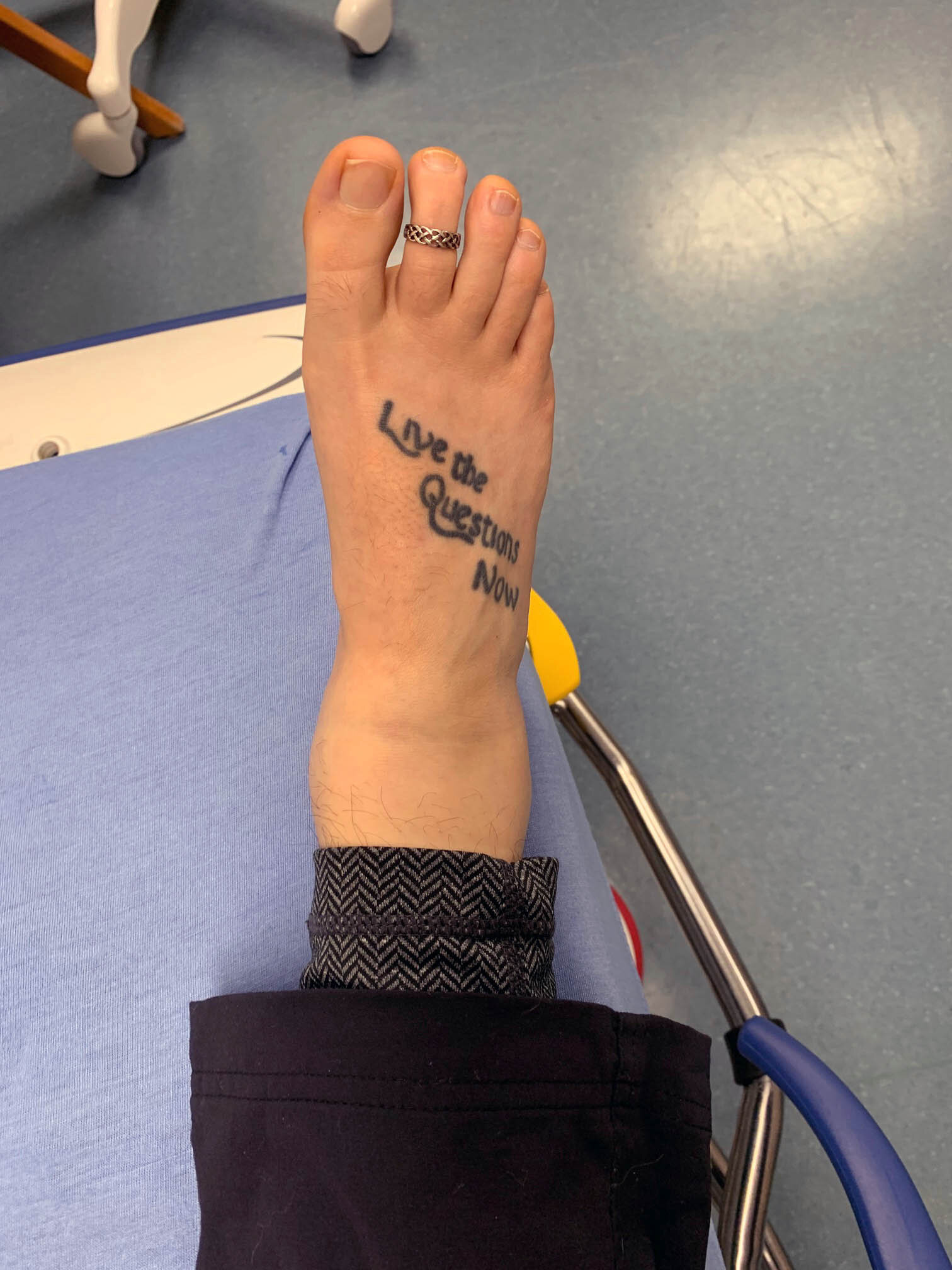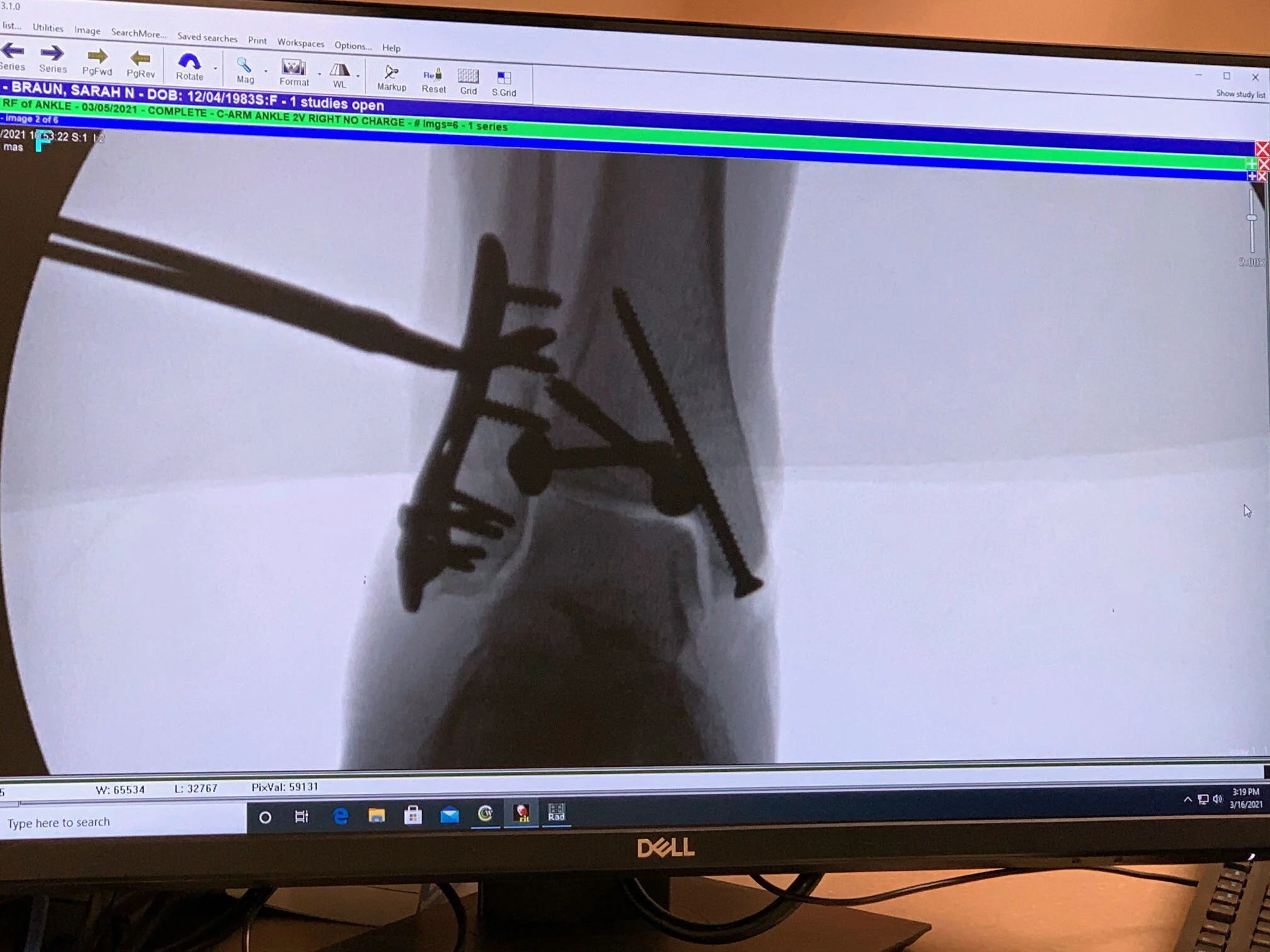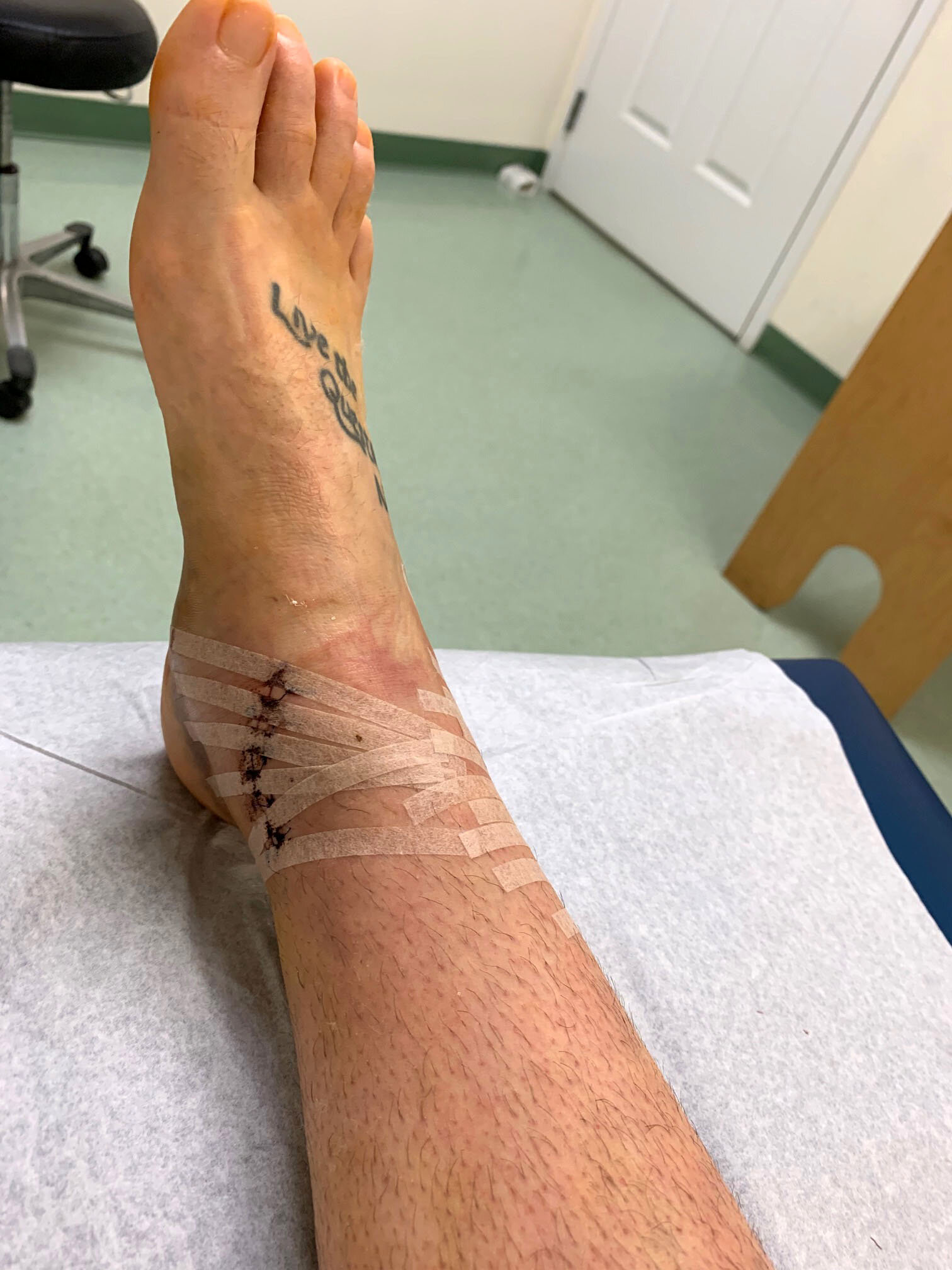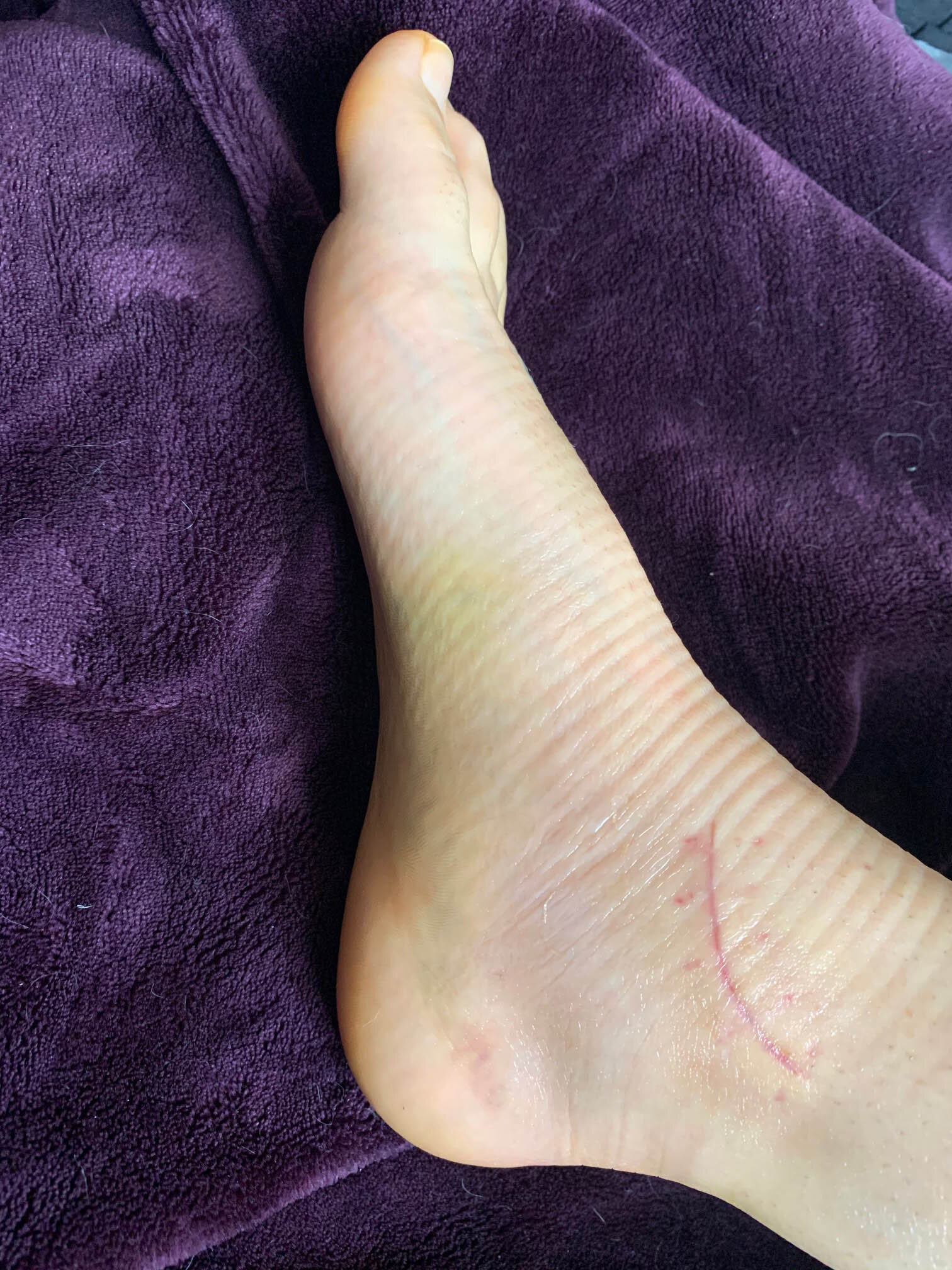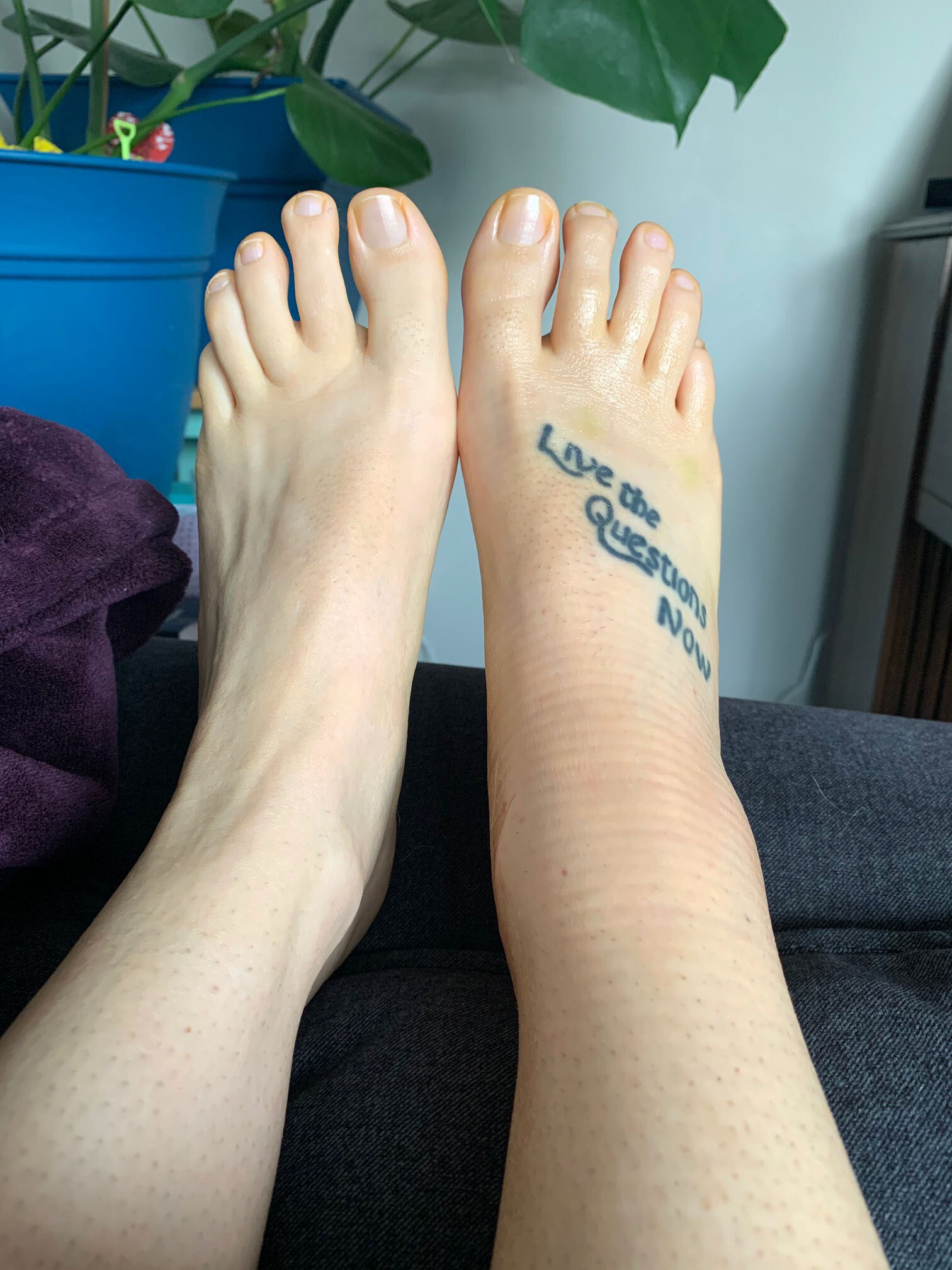Our Bodies as Our Teachers: Trimalleloar Ankle Fracture Healing — Part 1
Today marks the one month anniversary of breaking my ankle, which feels pretty significant and surreal. I’ve debated whether or not to share more about my experience here and ultimately decided that it would be beneficial.
The blog posts I’ve found online that detail other people’s experiences with various ankle fractures have been really helpful for me to understand what’s happening to me and what to expect in the months ahead. So here’s my contribution to this collection of stories of healing.
I plan to share my experience thus far to capture my thoughts and feelings before the details get fuzzy and merge into a larger memory. I’ll update with a part 2 down the road when I’ve healed even more.
If you’re facing an ankle fracture or other type of broken bone journey, I truly hope this post will be of comfort to you.
The Beginning — Trimalleolar Fracture
It’s funny to remember the day I broke my ankle, as my hindsight on that day feels surreal. I had just finished my morning routine (hot lemon water followed by coffee with a side of philosophical chit chat with my partner), which had turned into stressing about my business and life in general. I had decided to go for a walk because I process my thoughts really well that way.
So, I put on some warm clothes and my cozy hiking shoes. It was chilly and raining, after the previous day had been so warm. A warm day followed by a very cold day, with cold rain slicking it all up so much more = even more treacherously slippery ice than usual.
I turned on some chill binaural beats music in my ears so I could focus on my thoughts, then headed out to walk around my tiny Vermont town. I almost got to the end of the long driveway when suddenly I was on the ground. I still remember the awful cracking sound of my ankle as I landed. I sat there in copious amounts of pain, chill binaural beats playing in my ears highlighting the drastically changed vibe of my situation (and immediately pissing me off).
I didn’t waste any time trying to figure out what had happened. I FaceTimed my daughter in the living room, who I knew would immediately answer her phone. “*Groaning and moaning* Serenity, I just broke my ankle and I’m stuck on the driveway. Please get your dad and come get me.”
The two of them rushed out and hauled me inside to the couch. I started stripping off my shoe, sock, earphones, jacket and feeling just overwhelmingly uncomfortable. I sat there and watched my ankle swell up and noticed that it was at an angle that wasn’t quite right. It was definitely dislocated. Maybe I had only dislocated it? (Ah, such hopeful thinking…)
After some lightly panicky conversation with my daughter and partner, I just knew I had to go to the emergency room at our local hospital. This injury was sadly waaaaaay out of my knowledge wheelhouse. So, they helped me to the car and off we set.
Finally at the ER, that ankle looking all kinds of wrong…
A First Time for Everything: the ER Visit
I’ve never needed to go to an ER before. I’ve been to urgent care clinics for things like my son dealing with a concussion. But never anything super emergent. This was definitely a strange first for me.
We got to the hospital and the two of them helped me inside. Since these times are pandemic times, that’s as far as they could go. So I then had to navigate the rest all alone.
The kind hospital staff got me checked in and wheeled me into the waiting room. I vividly remember sitting there slightly rocking back and forth in the wheelchair, enduring the most incredible nerve discomfort ever. I learned later that it was caused by my dislocated ankle telling me that things weren’t in the right place.
An older man was parked in a wheelchair near me and we both waited in quiet agony, lost in our own personal worlds of pain. As he moaned and groaned, writhing about in his chair I knew he was far worse off than I was. I felt for him and hoped they could get him care soon.
After about a 15-minute wait, someone finally came for me and wheeled me back into a room. A nurse took a look at my ankle and decided that I needed x-rays right away. Once I was in the x-ray room, the technologist helped me onto the table and got my leg set up for x-rays. At one point she jumped as she moved my leg, as the suddenly free bones ground over each other in a weird, very-wrong way.
She kindly showed me the x-rays, told me she couldn’t diagnose, but pointed to where my bones were floating freely. It was pretty clear I’d done some serious damage.
Back to the ER patient room I went, waiting for someone to come decide what needed to happen next. My nerves were still on fire, but I was managing pretty well overall. Oddly, breaking bones didn’t hurt like I thought it would. At this point, the dislocation was the most uncomfortable of all. (Thank you adrenaline and endogenous analgesia — we have such brilliant bodies!)
Realigning My Ankle
Finally, a physician’s assistant came to help me get comfortable again. She told me what the x-rays were saying — it was a pretty clear trimalleolar fracture and would require surgery to repair. I attempted to protest and asked for more details as to what would happen if I didn’t get surgery. She was incredibly kind and took the time to talk it out with me.
It was then time to get my ankle back in alignment.
I was clear with her that I like to be a very active participant in my care and didn’t want anything done to me without loads of explanations and narration. I wanted to watch (mostly because I’m ridiculous and fascinated by all things body and science).
She was honestly one of the kindest people I’ve ever met and readily agreed to my approach. She also kept checking in on my pain and was surprised that I wasn’t having much more than nerve irritation. (See my hormone comment above - the body is truly amazing.)
She first injected my ankle with lidocaine for some mild pain relief, which was incredibly cool to watch (yes, I realize I’m a weirdo). Then she had a student PA assist her in getting my ankle aligned and splinted.
Unfortunately, this must have been the first adjustment of this type that the student had ever witnessed, and she had to pretty quickly sit on the floor with her head between her knees. I felt for her and made sure to tell her that I wasn’t feeling any pain. I chit chatted a bit with her to help get her mind off of it all. (Yes, I go into caretaker mode even when I’m the one needing care - ha!)
After a nurse came in to help hold my leg up, they were able to realign my ankle and started to wrap and plaster the whole thing up. Throughout it all, they kept remarking how crazy it was that I wasn’t having much pain. I thought it was pretty crazy too.
(Side note: closed reduction — the name for bone realignment — is one crazy feeling procedure. It’s more relieving than painful. But definitely mentally squirmy to watch done!)
After they got me splinted and bandaged up, they sent me in for another round of x-rays to make sure she’d gotten things all perfectly aligned and then sent me over for a CT scan to pre-prep for surgery. They were too busy to do the surgical repair that day, but scheduled me in for a few days later.
Next up was getting me set up with crutches and care instructions, then checked out to head home. The whole ordeal lasted 2-ish hours. My daughter and her friend picked me up, then we headed home so I could process and contemplate this new journey ahead.
Hello ankle fractures — fibula fracture; medial + posterior tibia breaks.
Processing + Soul Anguish
Over the next few days, I got my couch living room station set up, processed what had happened, and rode the remaining waves of adrenaline and mental shock. Surprisingly, my pain was still only isolated to nerve inflammation and discomfort when I rotated my leg (I could still feel those loose bones jerkily grinding over each other — super ugh and my least favorite sensation of this entire ordeal).
But I also agonized over my predicament. I debated surgery in my mind. I researched online for alternatives. I contemplated what an indigenous healer would do to help me heal. I wondered if there were any old school doctors left out there who still knew how to heal bones without surgery. I cried about it and worked through the soul anguish.
I also practiced gratitude and acceptance. For a while now, I’ve been embracing the reality that life is a journey with lots of ups and downs, meant to help us grow. We can’t become bigger, brighter humans if we only hide away in our safe little nests.
I recognized that this was my invitation to become more me than I’d ever been before. The mental and soul anguish was all part of the process. I was being invited to be in my body in a way I’d never encountered before.
My body was, once again, teaching me how to get out of my head and into my life.
I knew the road ahead was going to really suck. And I could choose to see it as a refiner’s fire to be grateful for. So I practiced deep acceptance of all things: my situation, my anguish, my vacillating emotions, my technocratic culture, my feelings of loss for the healers we humans truly deserve, my loss of independence and increasing vulnerability.
I also practiced gratitude for western medicine’s interventions, even if I didn’t like or agree with them. I engaged my forgiveness mindset — forgiving the humans of my culture for becoming so lost in a mindset that doesn’t recognize soul, interbeing, or wholeness. Forgiving myself for not having the foresight to have planned out ahead of time exactly what I would do in this type of situation, therefore leaving myself unprepared and vulnerable to needing to choose my culture’s worldview and expectations.
I wrote more about these thought processes in my previous blog post here.
Surgery as Initiation
As the day of surgery approached, I still clung to my deep sadness of letting go of my holistic perspective and my deep cravings for a holistic indigenous wise woman healer who could help me heal my ankle through the power of my own body. Releasing the deep inner knowing (coming from my cells’ millions-of-years-old DNA, ancestral wisdom, and animistic worldview) that our culture and humanity could do so much better was really hard.
I began to see surgery as my passport to better understand modern western culture. This was my chance to see firsthand what it means to be a patient in the medical system. To experience the things that I hear others struggle with from a personal perspective. So I became reluctantly willing to put on my sociologist hat and be present for what the experience could teach me.
After all, this body isn’t meant to be treated like a museum piece. It’s meant to carry me through experiences that deeply nourish my purpose on this planet. This was just one more journey to help fulfill this whole being alive thing.
Luckily, my surgery was in the morning so I didn’t have to suffer very long without food and water. It was still pretty hard to not drink water though!
I talked to my body all morning, telling my ankle that we were going to go through something strange and super invasive. I apologized that I couldn’t do better right now and that this felt like the only feasible option. I gave her lots of love and kindness and forgiveness.
I knew that our nervous systems and cells register traumas at deep levels and that I was willingly walking into a major bodily violation conducted by strangers. I asked my body to take this as gently as possible and to work with me on releasing the trauma when we were whole and healed again.
A Gentle Disclaimer
I also offer this disclaimer: As I critique our western medical system I’m not critiquing individual healthcare professionals. They believe in what they’re doing and the majority of them bring their hearts into their work. They’re doing the best they can with the tools our society has given them. I send them nothing but love and thankfulness.
My critique is with our entire society’s worldview, not the individuals loving on humans in the restrictive ways they’re allowed to. I believe in a non-dualistic worldview that allows me to hold seemingly contradictory perspectives together gently and with equal weight. This allows me to see that western medicine was built on an inherently violent cultural model AND that healthcare practitioners are generally loving human beings.
On Being the Patient
Getting set up for surgery was pretty straightforward. I was checked in, brought to a patient room, asked to change into a hospital gown, and set up in a bed. A kind nurse got me hooked up to my first IV ever and talked me through the next steps. She sat with me, chatting and answering questions. She even warmed up and massaged my very cold broken-ankle toes and found a way to cover them over the cast with a stretchy hospital sock. (Cue the tears of gratitude.)
The surgeon and the PA I had worked with in the ER both came to discuss what was going to happen. Then a nurse anesthetist came to talk with me about inserting nerve blockers into my leg to deaden the nerves. I asked for a transparent list of risks and detailed verbal outline of the procedure. I weighed the pros and cons, ultimately deciding that less narcotics in my IV and after the surgery sounded like a good enough reason to say yes to the nerve blockers.
I liked the nurse who was helping me, however, I could tell that it’s routine for nurses to use euphemisms and not offer too many details to patients. I found this exceptionally frustrating, as she accidentally mentioned things that were in my IV instead of straightforwardly informing me.
It seemed as though hospital staff tends to put all kinds of things in IVs without much information or consent. I assume that the consent form I signed for surgery was seen as me giving consent to all the standard procedures, even though I much prefer to be verbally informed along the way and treated as an intelligent adult instead of a scared child.
This whole experience gave me a serious insider’s view of how the medical field uses the vastly disempowering Informed Consent model instead of the much more empowering Informed Choice model. I honestly don’t believe that informed consent truly happens in medical care very often, as it tends to look more like signing off on things that aren’t ever truly explained (and there’s rarely enough time for questions). This is partially a problem of the structure of the medical field and partially a problem of our social mentality that reinforces being a “compliant patient” and not taking self-responsibility for our own bodies. I will for sure tackle this topic in a future blog post.
With the nerve blockers in place and the drug Versed running through my system, I was whisked off to the operating room. I remember assisting in moving from the hospital bed to the operating table, then the sedation mask being clamped over my face. After that, I was completely under. I remember having strange dreams while in surgery, though I can’t remember what they were (which is probably for the best).
Post surgical hardware, ankle front view — open reduction internal fixation (ORIF) surgery.
Surgery lasted roughly 3 hours and I came-to about 30 or so minutes after it was over. I was asked by another nice nurse if I would like something to drink. Oh boy, would I! I asked for water, but she said that they don’t give water after surgery as it tends to just come right back up again. I asked what else they had to offer and she rattled off a list. Was the juice actually 100% juice? Nope. The list offered was essentially high fructose corn syrup in various colors and flavors. Yay. I decided to bite the bullet and accepted a ginger ale.
(Yes, I critique cultural healing systems that don’t fully comprehend the importance of real food as medicine. You can’t “heal” a body without nourishing it, no matter how you try. You can only bandaid symptoms and use a divide and conquer approach, which is antithetical to the true body-centered full-soul healing process.)
After a quick check-in with the surgeon, I dressed and got ready to head home. My leg was indeed just a heavy block of nerve deadened solid wood, which was a sensation I wasn’t sure I appreciated. (It seemed to only last 24-ish hours before starting to half wear off — a sensation I liked even less.)
After open reduction internal fixation (ORIF) surgery — ready to go home.
Settling Into a New Body
The first few days after surgery were quiet and I mostly felt like I was in a convalescing cocoon (which is a state I oddly enjoy as it’s an altered state of consciousness outside of the normal rush of life). I spent a lot of time quietly lounging on the couch, legs raised above my heart to decrease swelling. I was still in the post-injury shock-y phase, so just sitting there adjusting to everything that had happened.
Over the weeks since surgery, I’ve had lots of time to process. The reality of the situation has been sinking into my bones. I’ve learned a thing or two about surgical recovery that I didn’t anticipate. I’ve felt the spectrum of emotions and endured many long nights of fitful wakefulness.
Embarking on a journey is always a different experience than continuing to endure the journey when it’s been going on for a while. As this journey continues, I realize just how much more there is to endure and heal through. I’m also grieving the healthy, no-nonsense body I had before and facing the fact that my body will never be the same again.
Oxytocin aplenty between love from friends (flowers) and my fluffy doggie friend.
A few things that have been a big deal for me:
While I didn’t have much “pain” after surgery, the nerve damage, pins and needles sensations have been excruciating in more of a mental anguish sort of way. They’ve changed over time, but generally the nerves are just so uncomfortable to be present with 24/7.
Sleep has always been my fiercely guarded sanctuary. It’s super disturbed right now and I’m grieving for my safe healing space. I long for the day when I can cozy up under my comforter and feel peace in every part of my body — truly relaxed and sleepy. For now, I’m managing my lifestyle choices as much as possible and playing with different hacks to try to get a decent night’s sleep. I’m often taking 1-2 hour naps during the day to help make up the difference as well. (This is also useful to break up the time I’m lying on my back, which has been on/off again achy from all of the laying around.)
The mental and physical exhaustion is for real. Every task feels like a major energy ordeal. Crawling up and down the stairs is a workout. I’ve had to say farewell to a productivity mindset altogether and take things verrrrrry slowwwwwly.
My knee scooter has become my new best friend. Crutches are just not all that helpful and I’ve had more than one experience of a single crutch sliding outwards and almost causing me to fall. You can’t carry anything in your hands with crutches. With my knee scooter, I’m 100% secure and can rest my knee comfortably for longer periods of time. I can grab things from the kitchen and put them in the scooter’s basket, thereby making myself more independent and my family less compassion fatigued. It’s a miracle.
The first few days after my injury, my whole body ached due to using my muscles in new, explosive ways. My left leg was trashed from being used exclusively. My arms were exhausted from hauling my whole body up the stairs. My right hip ached from constantly holding up my injured leg as I moved about the house (those casts are crazy heavy). Now, my body’s ability to carry me around has seriously leveled up. But my aches are now of the sedentary nature — lower back aches from poor posture, shoulder pinches from being rounded almost all the time. I’ve had to implement some new sitting/lying down techniques to support resolution of these deep aches, including consistent pilates-style floor workouts + stretches to use muscles so they can feel better.
Watching the ice and snow melt outside and having a direct line of sight to our local Rail Trail has been a special kind of mental torture. I thrive on daily long walks and weekly rigorous hikes (the benefits for me are physical as well as mental/emotional/spiritual). I was beyond thrilled for winter to leave so I could get back to my hiking and forest wandering. Sitting here seeing others go about their lives normally feels like vinegar on a wound.
Dealing with a stiff-as-hell ankle is pretty depressing. Seeing how far from healthy it currently is feels demoralizing sometimes. Doing the stretches and massaging the heck out of my foot feels good, but often the progress just feels like it constantly back-tracks. I often wonder how different this part would be minus the surgical injuries…
I’ve always been a hot bath person and now they’ve become even more essential for me. It’s a place where my nerves feel soothed and my foot feels weightless. If it weren’t for a daily morning hot bath right after I wake up, I’m not sure I’d be able to deal with any of this very well.
I have the constant strange feeling that part of me is still stuck on the morning of March 1st. It’s a surreal sensation that seems as though I’ve jumped into a different timeline and perhaps I’ll eventually make it back to that time and place. Obviously, I know that’s not true. But it’s a deep sensation in my body that I just can’t shake. I know that I’ll need to do some healing there eventually to (as Sarah Kerr often says) help catch my soul up to my body and reality.
Left: the cast comes off at 10 days post-op on March 16th; Middle & Right: April 5th healing progress.
Whole-Person Healing Insight and Support
Though I could turn this post into an even longer deep dive into all of my experiences, I think it’s best to break up my thoughts into smaller chunks so they reach the people that need them the most. So I’m going to write a series of articles for anyone who needs support and ideas while holistically healing from an injury and/or surgery.
Here’s a highlight reel of what’s coming up soon…
I plan to write an article detailing the holistic supplements, herbal remedies, and nourishing foods I’ve integrated into my life during this experience. As I believe that food is the most powerful medicine, I’ll explore this in depth with a focus on nourishing and loving our bodies from the inside out.
There have been lots of things in this journey that have surprised me, both physically and emotionally. And even just practically. I will summarize these with actionable tips and thoughts about how to deal with the frustrations of a sudden disability.
While our society tends to treat experiences like these as ho-hum, everyday “Yeah, well I know lots of people who have been through that. So what?” experiences… The reality is that trauma of all kinds and the aftermath of healing is a major transition for your body and soul to process. I’ll write a blog post about my own experience with this, how to honor grieving the losses, and rituals to get through. I’ll also explore how these kinds of experiences can be blessings in disguise, as they clear our heads, highlight our priorities, and catapult us onto our paths of purpose (if we allow them to).
I’ve had a ton of experience-based insights about western medicine that correlate with my perspective and worldview on birth in our society. So. Many. Parallels. This article will explore these ideas further, exploring the politics of being a “patient” in our society, how our culture approaches death, loss, and transition (and what the heck that has to do with healing + birth). I’m especially excited to dive into writing this one.
I’d also like to write a post about the parallels between somatic trauma and pain science, as they both involve the nervous system and are crucial for understanding our body’s infinite wisdom and how to translate that into healing trauma responses and sensations of pain (both physical and emotional, as they are inextricably intertwined). This is a journey I’m on right now and I can’t wait to share more about what I’ve learned and experienced.
In 2-4 months, I’ll follow this up with an update post on how things have progressed and how I’m healing up (including re-learning to walk again — crossing my fingers this goes well!).
I’ll likely write a final summary post on the one-year anniversary of my ankle break (March 2022) that reflects, processes, and supports anyone going through this significant and very-human right of passage. It’s not easy and I’m here for all the knowledge-sharing and space-holding.
Finding peace, rest, and self-care — activating my parasympathetic NS + oxytocin release as much as possible. Healing is hard, but also beautiful.
If you’ve made it this far, it probably means that you’re either going through something similar or you’ve been here before. Or you just really like reading and learning about the experiences people go through in life (bless your empathetic heart).
If you’re in the middle of healing from an injury like this, I’m sending lots of hugs and support. This sucks and crying helps. But also, you’re resilient and your body is brilliantly wise and adaptive. You can come out stronger and with a greater depth to your experience of your soul.


